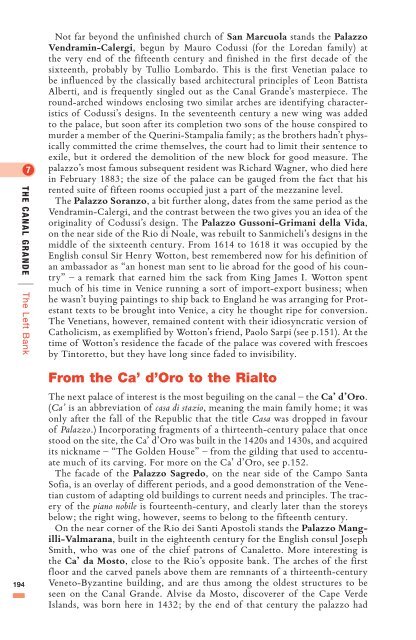Create successful ePaper yourself
Turn your PDF publications into a flip-book with our unique Google optimized e-Paper software.
<strong>the</strong> canal gr<strong>and</strong>e <strong>The</strong> Left Bank<br />
|<br />
194<br />
Not far beyond <strong>the</strong> unfinished church of San Marcuola st<strong>and</strong>s <strong>the</strong> Palazzo<br />
Vendramin-Calergi, begun by Mauro Codussi (for <strong>the</strong> Loredan family) at<br />
<strong>the</strong> very end of <strong>the</strong> fifteenth century <strong>and</strong> finished in <strong>the</strong> first decade of <strong>the</strong><br />
sixteenth, probably by Tullio Lombardo. This is <strong>the</strong> first Venetian palace <strong>to</strong><br />
be influenced by <strong>the</strong> classically based architectural principles of Leon Battista<br />
Alberti, <strong>and</strong> is frequently singled out as <strong>the</strong> Canal Gr<strong>and</strong>e’s masterpiece. <strong>The</strong><br />
round-arched windows enclosing two similar arches are identifying characteristics<br />
of Codussi’s designs. In <strong>the</strong> seventeenth century a new wing was added<br />
<strong>to</strong> <strong>the</strong> palace, but soon after its completion two sons of <strong>the</strong> house conspired <strong>to</strong><br />
murder a member of <strong>the</strong> Querini-Stampalia family; as <strong>the</strong> bro<strong>the</strong>rs hadn’t physically<br />
committed <strong>the</strong> crime <strong>the</strong>mselves, <strong>the</strong> court had <strong>to</strong> limit <strong>the</strong>ir sentence <strong>to</strong><br />
exile, but it ordered <strong>the</strong> demolition of <strong>the</strong> new block for good measure. <strong>The</strong><br />
palazzo’s most famous subsequent resident was Richard Wagner, who died here<br />
in February 1883; <strong>the</strong> size of <strong>the</strong> palace can be gauged from <strong>the</strong> fact that his<br />
rented suite of fifteen rooms occupied just a part of <strong>the</strong> mezzanine level.<br />
<strong>The</strong> Palazzo Soranzo, a bit fur<strong>the</strong>r along, dates from <strong>the</strong> same period as <strong>the</strong><br />
Vendramin-Calergi, <strong>and</strong> <strong>the</strong> contrast between <strong>the</strong> two gives you an idea of <strong>the</strong><br />
originality of Codussi’s design. <strong>The</strong> Palazzo Gussoni-Grimani della Vida,<br />
on <strong>the</strong> near side of <strong>the</strong> Rio di Noale, was rebuilt <strong>to</strong> Sanmicheli’s designs in <strong>the</strong><br />
middle of <strong>the</strong> sixteenth century. From 1614 <strong>to</strong> 1618 it was occupied by <strong>the</strong><br />
English consul Sir Henry Wot<strong>to</strong>n, best remembered now for his definition of<br />
an ambassador as “an honest man sent <strong>to</strong> lie abroad for <strong>the</strong> good of his country”<br />
– a remark that earned him <strong>the</strong> sack from King James I. Wot<strong>to</strong>n spent<br />
much of his time in <strong>Venice</strong> running a sort of import-export business; when<br />
he wasn’t buying paintings <strong>to</strong> ship back <strong>to</strong> Engl<strong>and</strong> he was arranging for Protestant<br />
texts <strong>to</strong> be brought in<strong>to</strong> <strong>Venice</strong>, a city he thought ripe for conversion.<br />
<strong>The</strong> Venetians, however, remained content with <strong>the</strong>ir idiosyncratic version of<br />
Catholicism, as exemplified by Wot<strong>to</strong>n’s friend, Paolo Sarpi (see p.151). At <strong>the</strong><br />
time of Wot<strong>to</strong>n’s residence <strong>the</strong> facade of <strong>the</strong> palace was covered with frescoes<br />
by Tin<strong>to</strong>ret<strong>to</strong>, but <strong>the</strong>y have long since faded <strong>to</strong> invisibility.<br />
From <strong>the</strong> Ca’ d’Oro <strong>to</strong> <strong>the</strong> Rial<strong>to</strong><br />
<strong>The</strong> next palace of interest is <strong>the</strong> most beguiling on <strong>the</strong> canal – <strong>the</strong> Ca’ d’Oro.<br />
(Ca’ is an abbreviation of casa di stazio, meaning <strong>the</strong> main family home; it was<br />
only after <strong>the</strong> fall of <strong>the</strong> Republic that <strong>the</strong> title Casa was dropped in favour<br />
of Palazzo.) Incorporating fragments of a thirteenth-century palace that once<br />
s<strong>to</strong>od on <strong>the</strong> site, <strong>the</strong> Ca’ d’Oro was built in <strong>the</strong> 1420s <strong>and</strong> 1430s, <strong>and</strong> acquired<br />
its nickname – “<strong>The</strong> Golden House” – from <strong>the</strong> gilding that used <strong>to</strong> accentuate<br />
much of its carving. For more on <strong>the</strong> Ca’ d’Oro, see p.152.<br />
<strong>The</strong> facade of <strong>the</strong> Palazzo Sagredo, on <strong>the</strong> near side of <strong>the</strong> Campo Santa<br />
Sofia, is an overlay of different periods, <strong>and</strong> a good demonstration of <strong>the</strong> Venetian<br />
cus<strong>to</strong>m of adapting old buildings <strong>to</strong> current needs <strong>and</strong> principles. <strong>The</strong> tracery<br />
of <strong>the</strong> piano nobile is fourteenth-century, <strong>and</strong> clearly later than <strong>the</strong> s<strong>to</strong>reys<br />
below; <strong>the</strong> right wing, however, seems <strong>to</strong> belong <strong>to</strong> <strong>the</strong> fifteenth century.<br />
On <strong>the</strong> near corner of <strong>the</strong> Rio dei Santi Apos<strong>to</strong>li st<strong>and</strong>s <strong>the</strong> Palazzo Mangilli-Valmarana,<br />
built in <strong>the</strong> eighteenth century for <strong>the</strong> English consul Joseph<br />
Smith, who was one of <strong>the</strong> chief patrons of Canalet<strong>to</strong>. More interesting is<br />
<strong>the</strong> Ca’ da Mos<strong>to</strong>, close <strong>to</strong> <strong>the</strong> Rio’s opposite bank. <strong>The</strong> arches of <strong>the</strong> first<br />
floor <strong>and</strong> <strong>the</strong> carved panels above <strong>the</strong>m are remnants of a thirteenth-century<br />
Vene<strong>to</strong>-Byzantine building, <strong>and</strong> are thus among <strong>the</strong> oldest structures <strong>to</strong> be<br />
seen on <strong>the</strong> Canal Gr<strong>and</strong>e. Alvise da Mos<strong>to</strong>, discoverer of <strong>the</strong> Cape Verde<br />
Isl<strong>and</strong>s, was born here in 1432; by <strong>the</strong> end of that century <strong>the</strong> palazzo had







